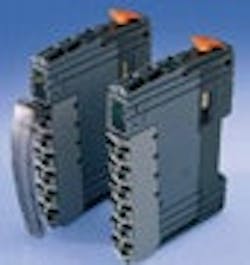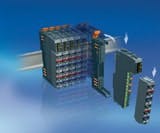New Controller for Stepper Apps
Of course, that’s also the thinking at B&R Industrial Automation. The company just introduced the X20 stepper motor controller, its first IP20-rated stepper controller for the X20 controller and I/O system. B&R presently supports stepper motor control through its X67 system, which is IP67-rated.
“Steppers have major cost advantages compared to servos for applications with low-speed and high-torque requirements along the lines of 100 rpm and 20 Nm,” says Helmut Kirnstoetter, international sales at B&R. “Steppers also are good when you have to be sure the axis won’t stall, or if you need amplifiers with built-in stall detection. In addition, you don’t have the maintenance issues that come up with brushed DC motors, and you can accomplish this at similar price levels.”
FOR MORE INFORMATION
Call 770/772-0400, e-mail [email protected], or browse to http://www.br-automation.com/.
Holding, boost, and continuous current can be set separately. This allows the coil currents to be individually adjusted for each motor. The motor is supplied with only as much current as it really requires.
B&R reports that X20’s additional features include automatic motor detection when booting, and stall detection that identifies overload situations or any unwanted blocking of the motor.
The module has four digital inputs. “These can be used as standard inputs for limit switches or encoders,” adds Kirnstoetter. “The integrated counter functions make it possible to connect an AB or ABR encoder for external feedback.”
Kirnstoetter adds this is another step in B&R’s integrated component approach. “The customer doesn’t need external wiring between the PLC and the stepper amplifier,” says Kirnstoetter. “The amplifier becomes part of the I/O system, so the diagnostic is greatly improved compared to a regular step and direction interface to the drive. Parameters can be easily changed through the PLC and HMI by the user.”
Consequently, using stepper motors still makes a lot of sense in many applications. This is especially true for users with components in the low-power range, where low speed and high torques are required, argues Kirnstoetter. “For these applications, servo drive systems still are more expensive. Also, the space requirements of a stepper motor are much smaller than for a servo motor in this power range.”
Indicators include channel status, operating status, and overall module status. All settings for the module are software-based and, says Kirnstoetter, are quick and easy to adjust, even during runtime. B&R’s programming environment—Automation Studio—simplifies the commissioning process.
Stepper motors can be operated in single-axis mode, with an axis group, or connected to other axes. The B&R soft CNC can handle up to 100 axes per interface.


